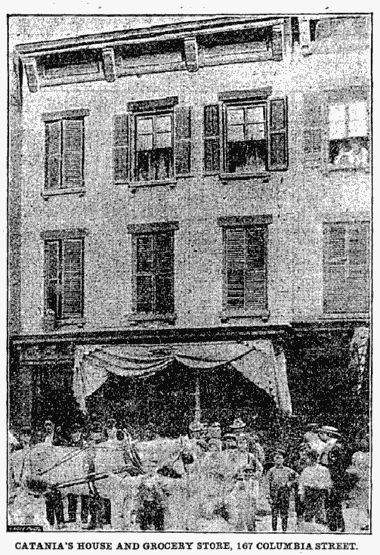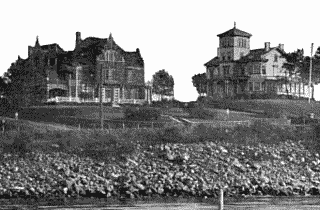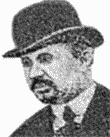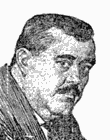Click here to return to main menu
The Sack MurderMob discipline ends the life of Joe 'the Grocer'By Thomas Hunt, Copyright © 2007 Fourteen-year-old John Mulqueen and three of his friends slid down the grassy slope from the foot of Seventy Third Street in the Bay Ridge section of Brooklyn. As they moved through trees and high weeds toward the rocky shore of New York Bay, they began removing their clothes. The sun was setting on a steamy Wednesday, July 23rd, 1902, and the boys were ready for a swim.
Before heading into the water, the four teens fanned out, looking for remote hiding places for their clothes. None wanted to take the chance of falling victim to the “chaw beef” trick. That practical joke involved tying tight knots into the shirt and pants of a bather. When the victim came out of the water, he would need to use teeth along with fingers to get the knots out. Onlookers would cheer, “Chaw beef, chaw beef...,” as the knots were undone. Young Mulqueen carried his garment bundle off into the grass, where he spotted what looked to be a large and very full potato sack. The boy found the object irresistible. He pulled a small knife from his clothes and put a slit into the sack. Underneath, he found another container, which appeared to be made of tougher material. He gathered his friends and began slicing into the inner liner. When the dusk light fell upon a portion of the sack’s contents, the boys recoiled. A man was inside, naked and lifeless. “It’s a dead man!” Mulqueen shouted. The boys retreated and put their clothes back on. Mulqueen, who lived a few blocks away at 321 Seventy Fourth Street, announced that the police were needed. He suggested that two of the group leave at once for the Fort Hamilton Police Station on Eighty Sixth Street near Fifth Avenue. The other two should keep watch on the area, he said. Joseph Donahue of 346 Seventy Fourth Street, Robert Pearsall of 1671 Third Avenue and William Chambers of 206½ Chambers Street all agreed that Mulqueen’s plan was sound. However, none of the boys wished to be left behind with the bagged corpse. They decided on an alternate plan – they would all go together to fetch the police. By road, the distance between their favorite swimming spot and the station was about one and a half miles. But the layout of Bay Ridge in 1902 – sprawling farms, large vacation estates and smaller homes surrounded by woods through which paths had been carved – allowed a more direct route and cut the trip to the station by about a third. Desk Sergeant Hughes somewhat reluctantly listened to John Mulqueen’s story. He doubted that the boys had stumbled upon a corpse in a bag of potatoes, but dispatched three police officers with Mulqueen and his friends in a patrol wagon to investigate. The Brooklyn officers followed Mulqueen’s direction to the sack and quickly verified his tale. Unprepared to conduct an investigation on the dark shore, the officers decided to take the large bundle back to their station. With considerable difficulty, they dragged the sack and its contents up the twenty-foot-high slope to the intersection of Seventy Third Street and Shore Road, loading it into the patrol wagon. A thorough examination of the corpse and its wrappings was conducted under the lights at Fort Hamilton Station. The outer covering was indeed a large potato sack. Stenciled on it were the words, “Paton’s Selected Scotch – 168 lbs.” Police determined that the inner lining had been assembled from some floor matting sewn into the shape of a bag. Another bag was found over the head of the victim. Around that was wrapped a few pages from the Sunday, July 20th, issue of the New York Times. Despite the date of the newspaper, investigators decided that the victim had been dead not longer than twenty four hours. He was a fairly large and powerfully developed man, with a height of about five feet and ten inches and a weight approximated at two hundred and forty pounds. He had gray eyes, black hair and a lighter color mustache. Police calculated his age at roughly thirty eight.
The cause of death was readily apparent. A deep gash ran across the throat from ear to ear, nearly disconnecting the head from the torso. The coroner noted that only a single cord of neck muscle remained intact. The victim had quickly bled to death, possibly losing a gallon of blood in the moments following his murder. Two other short stab wounds were found on the neck and face. A number of other wounds on the body were noted. The victim’s left thumb and forefinger were missing, the result of a much older injury. Several scrapes looked to be defensive injuries. Bruises were visible all over the body. Several larger bones had been broken. Investigators believed the broken bones might have occurred after death, as the body was stuffed into the floor mat bag. Heavy twine had been used to fold the body in half by joining the upper spine to the lower legs. This, too, was seen as a measure taken to allow for easy disposal of the victim. Detectives and patrolmen returned to the shore with lanterns to search for additional clues. They discovered another potato sack, which held a black suit, a shirt, shoes and a derby hat. The suit and shirt had been cut into large strips and were stained with blood. With the clothes, the detectives found two folded documents. One was a bill of lading for a tomato-based product imported from Italy. The other was a notice of eviction relating to a commercial establishment at 165 Columbia Street. Though the victim remained nameless, the documents suggested he was an Italian merchant doing business on Columbia Street. Further up the slope from the spot where the body had been found, Officers Burns and White noted that a section of fence had been knocked over and several saplings crushed. From the available evidence the detectives concluded that the two potato sacks had been driven to Shore Road and thrown onto the slope from a vehicle. They speculated that the perpetrators of the crime, believing the water was closer to the road than it actually was, expected the sacks to roll out into the bay. Officers under the command of Captain Michael Devanney of Fort Hamilton Station and sleuths of the Brooklyn Detective Bureau led by Captain James G. Reynolds met at Columbia Street to follow the only clues to the victim’s identity. Detective Sergeant Antonio Vachris was one of the investigators dispatched to the scene by Captain Reynolds. Vachris, originally from Genoa, Italy, was a resident of Brooklyn and knew its Italian population well. He spoke Italian and some Sicilian dialects. One of the few non-Democrats to advance through the ranks of the Brooklyn police, Vachris secured promotion several months earlier from roundsman - street supervisor of patrolmen - to detective sergeant in an unusual way. He sued administrators of the New York Police Department, charging that he had been performing detective sergeant duties at Brooklyn headquarters for years while being denied the corresponding title and pay. The courts found in his favor and compelled Police Commissioner “Colonel” John N. Partridge to grade Vachris appropriately. The building at 165 Columbia turned out to be a second-hand furniture store owned by Mary Noonan. The police awakened Noonan, who lived in an apartment above her business, and asked her about the eviction notice. She directed them to a grocery next door at 167 Columbia. In the apartments above that store, police found grocer Giuseppe Catania’s wife and six children. Vachris learned that Catania, known in the neighborhood as “Joe the Grocer,” had been missing since Tuesday morning. The disappearance had been reported to police at the Fort Hamilton Station and at the Mulberry Street headquarters in Manhattan. Catania’s son Charlie and son-in-law Dominick Tutrone had been searching for him all over the city. Catania’s wife collapsed and wept loudly after hearing of her husband’s demise. The police learned very little from their initial attempts to question her. Her wailing woke a number of neighbors and drew them to the apartment. Police interviewed the small crowd and began piecing together a possible explanation for the murder. They learned that Catania fought with a man named Vincenzo Trica on Sunday, July 20th. Catania showed up at Trica’s second-floor apartment on Hicks Street near the intersection with Summit and attempted to collect an old grocery debt of fourteen dollars. Trica refused to pay. The disagreement became physical, and Trica shoved Catania down a flight of stairs. When police asked Mrs. Catania to confirm that her husband had fought with Trica, she became more talkative. She dismissed the fight as a possible cause for further violence. She told Vachris that her husband and Trica patched up their relationship on Monday. Trica, she said, pledged to pay his debt the following day. 
According to Mrs. Catania, her husband left their home on Tuesday morning to meet Trica and collect his money. He then intended to head into Manhattan to pick up a case of imported tomato paste a friend had moved through the New York Customhouse. Catania had less than three dollars on him when he left the house, she said. She did not know if he ever made it to Manhattan. She insisted that her husband was very well liked in the neighborhood. He spent his evenings at home, on the front steps, chatting with neighbors. He liked to drink, she said, but never drank too much. Vachris and two other officers headed down toward Red Hook, Brooklyn, to check in on Trica. Lighting their way with a candle, the officers climbed the stairs of 604 Hicks Street at close to three o’clock in the morning. Immediately, they found reason to doubt that Trica’s apartment could be the scene of the Catania murder. The stairs were so narrow that it would have been impossible to move Catania’s lifeless body down them without leaving blood stains on the walls. The investigators saw no blood on the walls or the doorframes. They noted, however, that a panel in the door at the top of the stairs had been cracked. Trica slowly answered the police knocks on his door. He opened the door and took a moment to blink himself fully to consciousness before starting to answer a barrage of questions. He said he knew of Catania and owed him some money. He reported that he saw the grocer on Monday. There had been some unpleasantness the day before, but on Monday he apologized. He promised at that time to pay the owed fourteen dollars, and the two men shook hands. He had not seen Catania since that time. The broken door panel was the result of an angry Catania kick on Sunday, he said. The police placed Trica under arrest and searched his apartment and his clothing for traces of blood. There was none. The suspect went quietly along with the police, while detectives questioned residents of the neighborhood. Speaking with investigators, a Hicks Street barber confirmed the Sunday fight between Trica and Catania. After Catania tumbled down Trica’s stairs onto the sidewalk, the barber said, Trica charged at him. The two wrestled a bit before the barber separated them. According to the witness, neither man threw a punch or drew a weapon during that scuffle. When the Coney Island Police Court opened later that morning, Trica was brought before Magistrate Albert Van Brunt Voorhees Jr. and processed on suspicion of homicide. Trica identified himself to the court, said he was twenty four years old, a native of Palermo, single and employed as a fruit packer for Brooklyn businessman Luigi Nosdeo. He insisted he was innocent of Catania’s killing. Voorhees committed him to Raymond Street Jail. While the Sunday argument and Catania’s alleged appointment with Trica on the day he disappeared were evidence enough to hold Trica on suspicion for a few days, they were insufficient to convict him of murder. Brooklyn police spent much of the day Thursday trying to build a credible case against the prisoner. They discovered that Luigi Nosdeo’s business ventures included a livery stable at 629 Hicks Street that was filled with horses and wagons. Investigators speculated that Trica could have used one of the wagons to haul Catania’s body out to Bay Ridge, but they could find no blood evidence in any of the wagons or any indication that Trica had borrowed one of the vehicles. Detectives moved on to examine every wagon they could find in the South Brooklyn Italian community. None showed any signs of having been used to transport Catania. The murder weapon and the scene of the crime were just as elusive. Without those essential elements, there could be no hope of definitively identifying the murderer. Police turned their attention to four unidentified Sicilian men who lived in a room behind Catania’s store and were known to be friendly with Trica. They learned that two of those men had escorted Trica to Catania’s apartment on Monday as brokers of peace. Police interpreted Trica’s apology and his promise of payment as a deception designed to lower Catania’s guard. They therefore viewed the men who accompanied Trica during the apology as possible accomplices. Catania’s son Charlie revealed that the four men were the only ones in the neighborhood apparently uninterested in the grocer’s disappearance on Tuesday. Ordinarily, he told the investigators, the men would ask about his father when he was not around. On Tuesday, when Catania was conspicuously absent, they greeted Charlie without mentioning his father. Two of the men Charlie found suspicious were interrogated by police late on Thursday, as Catania’s body was brought to the front parlor of his Columbia Street home. The men claimed to know nothing about the murder, other than what they had read in the newspapers. No weapons and no signs of a violent struggle were observed in their apartment. During the day on Friday, a large crowd of mourners filed through the black draped front parlor of the Catania home to pay respects to the grocer and offer condolences to his family. The room was kept dark, the only light emanating from a tall candelabrum. Due to the darkness and to the high collar the undertaker placed on the body, Catania’s enormous neck wound was unseen. A well attended requiem was held at the Church of the Sacred Heart of Jesus and Mary on Saturday afternoon. The grocer’s body was interred at Holy Cross Cemetery later in the afternoon. Police officers and detectives were on hand through every stage of the funeral, examining the faces of attendees and listening to their hushed conversations. Just a few days into the investigation, Detective Sergeant Vachris decided that there was no credible case against Trica or the four men who lived behind Catania’s shop. He began to explore other possibilities. One of those was provided by Catania’s son-in-law Dominick Tutrone, who spoke about it with a reporter from the Brooklyn Daily Eagle newspaper on Saturday morning. “He was a good man,” said Tutrone. “When my wife [Catania’s oldest daughter] died, he was very kind to me. And, as if he did not have children enough of his own, took my two little ones home too.” “What is your opinion of this murder?” the reporter asked. “I do not know what to think. It seems too horrible to contemplate. I cannot think that this man Trica had anything to do with it. It seems impossible to believe that for such a trivial thing as fourteen dollars such a murder would be committed... Italians do not kill their friends for so slight a cause. There is something else behind this. Vengeance, I believe.” Tutrone indicated that Catania had lived a peaceful life for all of his two decades in Brooklyn. He said, however, that a vendetta could have arisen from some earlier incident in Catania’s home city of Palermo, Sicily. “These people cherish a wrong a long, long time, years and years,” Tutrone explained. “Of course there is talk, lots of it. But I do not know of anything that he ever did in Sicily that would result in his murder. He was not killed for his money. That is certain, for he had no money. He was not killed by any enemy he had made in this country. I am sure of that. Then the only thing that is left for us to believe is that this thing was done to settle up some old score.” According to the Eagle, the “lots of talk” to which Tutrone referred was gossip relating to a Palermo offense allegedly committed by Catania against one or two men. One wild rumor specifically charged that he murdered two fellow Sicilians. The Italian quarter of Brooklyn, the newspaper said, was convinced that the families of the injured parties had tracked Catania to Brooklyn and avenged their relatives. Vachris gradually came to support a version of the vendetta theory. Unlike the Palermo murder rumor, the detective’s version left Catania innocent of any wrongdoing. The grocer merely testified against two men charged of murder in Palermo. As a result of the testimony, the defendants were convicted and sentenced to 20-year prison terms. They swore revenge. Fearing for his life, Catania fled to Brooklyn. Over the years, he became comfortable and forgot about the murderers he helped convict. When the two men were released from prison, they learned of Catania’s whereabouts, traveled to Brooklyn and fulfilled their vendetta.
On Tuesday, July 29th, Vincenzo Trica was discharged from custody. The police admitted that, while there was evidence of some bad blood between Catania and Trica, they had no evidence linking Trica to the Catania killing. Brooklyn police interest in the Catania murder diminished in the following weeks. The case remained officially unsolved. However, the murder became a matter of intense – though covert – interest to Agent William J. Flynn and his fellow Secret Service men of the New York bureau. The Secret Service had been trailing suspected members of a gang of Brooklyn and Manhattan counterfeiters for more than a decade. That gang of immigrant Sicilians was believed to be importing counterfeit American currency within shipments of produce and olive oil from Mafia contacts in Sicily. While the Secret Service had managed to shut down some of the smaller operators in the counterfeiting ring, men who had been caught passing phony bills, it had little evidence against the suspected leaders. As the police attributed the slaying of Catania to an unknowable team of old-world assassins, Flynn developed a contrary opinion. Believing the Columbia Street shop to be one of a number of New York area groceries used to distribute phony bills, Flynn was certain that Catania was killed because of his habit of drinking and chatting socially with his Brooklyn neighbors. The grocer occasionally drank a bit too much and chatted about things others wished to keep secret, Flynn concluded. Catania’s near-beheading was an act of savage discipline administered by ruthless higher ups in the counterfeiting ring. |
|||
Copyright © 2007
Thomas Hunt
P.O. Box 1350
New Milford, CT 06776-1350
thunt@cagedwolves.com


